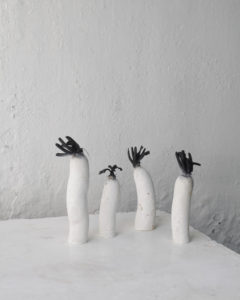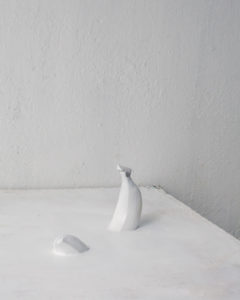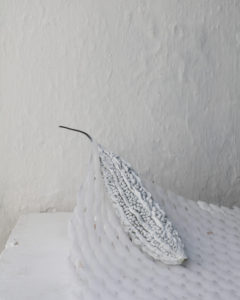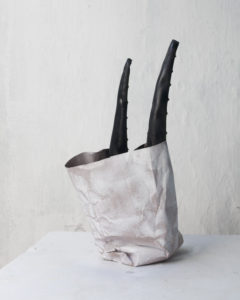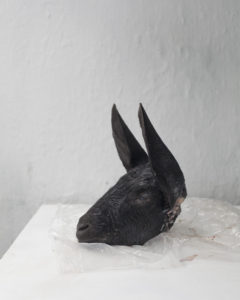THE TABLE
Q. You mention the American author, David Foster Wallace in your introduction. How is reading part of your creative process?
Reading helps me to identify my interests and formulate projects. For instance, prior to a workshop I recently attended in Kathmandu, I had just finished reading Fahrenheit 451 by Ray Bradbury and the dystopian mood of this novel transferred to the story I eventually ended up working on during the workshop. By reading both fiction and non-fiction, I am able to get inside the minds of people who have either studied the subjects I would like to capture or are part of the project itself. Words can lead to images.
Q. How much do you feel photography is able to change our perception of reality?
Too much. The oft-quoted line by American sociologist, Lewis Hine comes to mind —”photographs may not he, but photographers can be liars.” Photography was originally considered by many as a way of objectively representing reality and historically this notion has been taken advantage of to change our perception of reality in different forms —be it political propaganda, advertising, even social media. Although the scale of individual misrepresentations might arguably be smaller, I feel it is more ubiquitous than ever. This whole phenomenon of Instagram influencers for instance —there’s now a career in amassing a following by incessantly sharing hyper-real photographs of yourself using products that brands want to sell and there are agencies that provide you with photographers to help you get there.
Q. Why / how did you choose to explore the genre of still-life?
One of the assignments given to us at Pathshala in Dhaka was called ‘Objects as Sculpture’. It was for this assignment that I started working on my project The Table. This was around the time when the Brexit vote had just happened, Trump was about to be elected and in India, Gaurakshaks were at their merciless best. Reality seemed unreal, and I was thinking of a way to communicate my perplexity through photography and abstraction using still-life.
Q. Why is photography the medium of your choice and what are your practical and theoretical challenges you have faced?
Like most people, photography was the medium to which I had immediate access. I liked to travel and photography went hand in hand with that, taking me to places I would otherwise have no reason to visit, expanding my understanding of the world around me. It also acts as a personal journal; most of my memories revolve around it. It is also a reminder of the existence of beauty, in the ordinary as much as the extraordinary.
Photography is a medium that inherently looks outwards, so as a tool for expressing inner feelings (something I have gravitated towards of late) it becomes rather challenging.
I often wonder how much of what I want to communicate is transferred to the viewer on looking at my photographs (or is it even necessary, shouldn’t the viewer have the liberty to interpret in their own way?). I’m concerned that very often photographs are unable to transcend aesthetics and truly move me the way literature, cinema and music can.
Q. How has education/mentoring changed your practice over time? What were your expectations of the course/worKshop?
I have a much greater understanding of the medium, its history and practice through the education I have received which is what I was seeking when I enrolled. It has given me the space and time to experiment greatly, and through this process I have become aware of my strengths and weaknesses. Through education, I have also come to realise the significance of knowing myself and my position as a human being better, and how this reflects my choice of projects and photographic approach. The most honest and beautiful works for me are the ones that have a strong connection to the author’s personal life and interests. I now have a Keen awareness of the responsibility of representation, and I give as much importance to the things that come before and after taking photographs —research, editing, presentation. Photography is no longer just about taking beautiful images – I now realise the importance of pushing myself, being vulnerable, feeling more, being more empathetic, more connected and I know through experience that all this is easier said than done. I now understand what other photographers mean when they talk about the ‘loss of innocence’ and sometimes I feel ignorance is Hiss.
Q. How do you think photography will change in the future and what will be the role of the University/Festival/WorKshop?
There is no doubt that more and more people will be taking photographs, and therefore the role of a photographer is likely to shift even more from mere objective representation. The universitylfestivallworkshop environment (at least the ones that don’t place restrictions on creativity) acts as an ideal barometer to track these changes. The theme for the last edition of Chobi Mela was ‘Transition’ and the works that were shown reflected a shift in the approach towards photography. On display there were fewer documentary projects made in the traditional way and in its place were fictional narratives, video works with staticlphotographic frames, documentation of performances, pseudo-scientific investigations, travel journals, self-portraits and staged tableaus. Then there were the works based on archival material and ones that combine with other mediums like writing, drawing, sculpture and sound.
Q. What aspects should be included in photography courses to lend criticality?
A majority of the photography courses that are presently offered focus mostly on the practical aspect which is great for the vocational route, but in order to lend criticality, I feel courses should offer students a much deeper understanding of the medium by teaching its history, discussing ethics, experimenting with different modes of storytelling, collaborating it with other mediums etc. Pathshala offered ancillary subjects like Visual Anthropology, History of Art and Creative Writing, and very often it is from these subjects that I drew inspiration and a greater understanding for and about my photographic work.
All images from the series The Table 2016-2017 Digital
